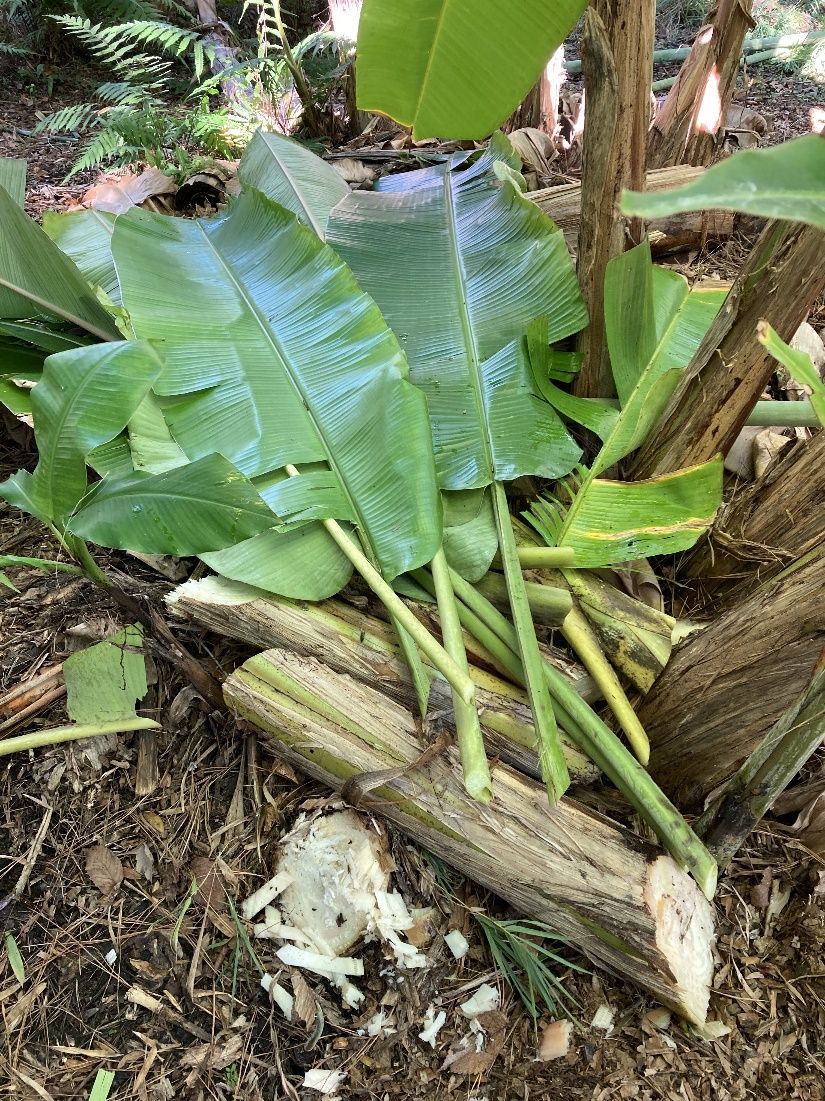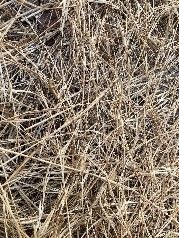Introduction
Mulching is the practice of spreading material around the base of a plant to protect the plant, conserving moisture or suppressing weeds. Applying mulch is Florida-Friendly Landscaping™ Principle #4. This publication serves as a guide for homeowners and professionals to reference best practices on mulching and discusses mulch sources, application techniques, and management practices. It will clarify the mulch needs of fruit trees, shrubs, herbs, and vegetables to promote plant health. This information builds on the Edible Landscaping Using the Nine Florida-Friendly Landscaping™ Principles publication, https://edis.ifas.ufl.edu/publication/ep594, specifically building on recycling yard waste. For more info, see Recycling Organic Materials to Improve Your Florida-Friendly Edible Landscape: https://edis.ifas.ufl.edu/publication/EP599.
What is mulch?
Mulch is a layer of material applied to the surface of soil (Figure 1). Within that broad category there are an array of various materials to choose from. Mulch can be categorized as either organic or inorganic. Organic mulch is derived from living matter, is made of carbon and comes from renewable, biotic (living) resources. It includes wood chips, leaves, hay, and straw, as well as other yard waste such as cut branches and twigs or grass clippings. Leaf mulch is made up of whole or ground-up leaves. You can use any leaves from your yard or neighborhood (Figure 2). Pine straw/needles are sustainable and can be found at most local nurseries. Inorganic mulch is not made of living matter and is abiotic (nonliving). Examples include rocks, gravel, and crushed shell, or manufactured materials like rubber, artificial turf, or weed barrier. These inorganic mulches do not break down, can heat up the landscape and do not provide nutrition back to the soil like organic mulches do. Additionally, crushed shell, gravel and rocks do not prevent weeds, and they reflect heat, which prevents soil moisture loss. Recycled tires and rubber mulch should be avoided (Table 1) because chemicals are often leached into local water sources, float, and tend to wash away and end up in our waterways (Edil 2008).

Credit: Tia Silvasy, UF/IFAS

Credit: Rachel Gutner, UF/IFAS (left); Tina McIntyre, UF/IFAS (right)
Organic and inorganic mulch have their role; however, inorganic mulch does not break down or decompose into organic matter that enhances soil quality. There are a few places where rocks are appropriate. For example, rocks belong in places like under a gutter, around a pool, or in landscapes as accents and on footpaths. Rocks and pavers can be used around a landscape bed to delineate it from the rest of the landscape, but the Florida-Friendly Landscaping™ program always recommends an organic-based mulch for herbs, vegetables, shrubs, and fruit trees.
Mulch Application and Management
When using mulch in established landscapes, apply to a depth of 2–3 inches around the plant. After the mulch settles fully, the frequency of replenishment varies depending on the kind of mulch selected and environmental factors. When mulching seedlings or small vegetables or herbs, however, apply mulch at a depth of 1 inch or less, so as not to cause growth problems for the plants. Do not apply mulch against the stem or trunk of the plant; this is called volcano mulching. Volcano mulching damages plants because the excess moisture can cause rot around the trunk and insect infestations. The base of the plant should be left bare so that the roots and trunk can still breathe. For large plants and trees, leave approximately one foot, and for smaller plants leave a couple inches.
Digging out old mulch is not necessary, because it will break down in the soil. Do not use wood mulch against your house. Termites can consume mulch, but they typically have other woods they prefer over mulch. However, UF/IFAS research (Oi and Wheeler 2019) indicates that termites may be present in mulched areas more frequently than in areas where mulch is nonexistent. We recommend gravel around the perimeter of the home. Other practices to help deter termites include leaving space between plants and walls and applying no more than 1 inch of water when you irrigate and removing any stumps from dead trees.
Some gardeners think fungus, mushrooms and mycorrhizae are harming their turfgrass, trees or landscape. Fungal growth on plant leaves is usually not good, but ground fungus, which includes mushrooms and mycorrhizae, is a natural part of the environment and symbiotic or beneficial to trees. Fungi are decomposers, so they naturally break down wood or other organic material in the soil. If you are concerned about fungus, reduce or stop irrigation. Water and rain encourage fungal growth, so if you reduce watering, fungal growth should decline.
Mulching for Specific Needs of Edible Species
There are a wide variety of edible species, and general mulching principles can apply, but choosing the right mulch for your food crops can improve plant health. Some trees that require good drainage can be inhibited by a thick layer of mulch, and therefore a coarser mulch that will not rapidly break down should be selected. Species that need good drainage should not be mulched with finely ground mulches, because they can inhibit good drainage in our sandy soils. For example, blueberries are often mulched with pine bark because they like well-drained acidic conditions. Plants like citrus trees have shallow roots and are susceptible to root rot and damage due to excessive wetness, so they require an open base around their trunk. For these trees and shrubs, select an organic mulch, apply at a depth no deeper than three inches, and leave at least one foot from the base of the tree. Pineapples, avocados, and citrus trees benefit from good drainage, so this practice is recommended for those species (Figure 3).

Credit: Tina McIntyre, UF/IFAS
Conversely, bananas should be mulched 2–6 inches deep using their leaves or wood chips because they require significant moisture (Figure 4). Lighter mulches like leaves, straw, dried grass clippings, or compost are better for saplings and small plants like herbs and vegetables (Figure 5, 6, 7).

Credit: Tia Silvasy, UF/IFAS

Credit: Tia Silvasy, UF/IFAS

Credit: Rachel Mathes, UF/IFAS

Credit: Tina McIntyre, UF/IFAS
Benefits of Mulch
Benefits of mulch for your edible plants:
- Conserves and retains soil moisture; reduces evaporation
- Buffers soil temperatures
- Inhibits weed growth
- Protects plant roots
- Adds uniformity and a beautiful aesthetic
- Reduces soil erosion
- Adds organic material to the soil
- Provides an increased area for root growth
- Protects plants from lawnmowers and weed eaters
- Enhances microbiome
Types of Mulch
Leaves are an excellent mulch to use in your landscape (Figure 8). They naturally fall from trees and are a renewable, sustainable resource that can be used for mulching garden and landscape beds. Leaves that fall in your neighborhood are sourced locally, so you can ensure that you are not introducing new pests or diseases where you live. Fallen leaves create a “self-mulching” area under the tree. If the amount of fallen leaves is excessive, gather some and spread them onto garden and landscape beds. Leaves can be placed into a trash can and broken down with a string trimmer or by hand. If the look of leaves is bothersome or concern exists that they will blow around the landscape again, apply the leaves to the bed and add a small layer of wood mulch over the top so they will be weighted down and integrated into the soil. Types of wood mulch are displayed in Figure 9. For more information on recycling yard waste to use as mulch, read The Florida Yards & Neighborhoods Handbook, “#7: Recycle”: https://ffl.ifas.ufl.edu/media/fflifasufledu/docs/FYN_Handbook_2015_web.pdf#page=39.

Credit: Tia Silvasy, UF/IFAS

Credit: Frank Galdo, UF/IFAS
Table 1. This table describes types of mulch and if they are recommended for Florida-Friendly Landscaping™.
We would like to acknowledge Lyn Barber, Terra Freeman, Tom Wichman and Jennifer Marvin for their contributions to this publication.
References
Bauer, S., and J. Weisenhorn. 2018. “What to Do with Lawn Clippings.” UMN Extension. https://extension.umn.edu/lawncare/what-do-lawn-clippings
Crane, J. H., and C. F. Balerdi. 2019. “Banana Growing in the Florida Home Landscape.” EDIS 2006 (15). https://doi.org/10.32473/edis-mg040-2005
Freeman, T., T. Silvasy, L. Barber, T. Wichman, E. Momol, T. McIntyre, J. Rivas, and J. Marvin. 2021. “Recycling Organic Materials to Improve Your Florida-Friendly Edible Landscape.” EDIS 2021 (1). https://doi.org/10.32473/edis-ep599-2021
Liu, G. D., E. H. Simonne, K. T. Morgan, and G. J. Hochmuth. 2018. “Soil and Fertilizer Management for Vegetable Production in Florida.” EDIS 2018 (6). https://edis.ifas.ufl.edu/publication/cv101
Marble, C., and A. Koeser. 2022. “Improving Weed Control in Landscape Planting Beds.” EDIS 2015 (6):6. https://doi.org/10.32473/edis-ep523-2015
McLaughlin, J., and C. Yurgalevitch. n.d. Mulching Practices for South Florida. UF/IFAS Extension Miami-Dade County. https://sfyl.ifas.ufl.edu/media/sfylifasufledu/miami-dade/documents/landscapes-amp-gardening/mulch-practices.PDF
Oi, F. M., and M. Wheeler. 2019. “The Facts about Termites and Mulch.” EDIS 2006 (6). https://doi.org/10.32473/edis-in651-2006
Shober, A. L., and R. Mylavaparu. 2018. “Soil Sampling and Testing for the Home Landscape and Vegetable Garden.” EDIS 2009 (2). https://doi.org/10.32473/edis-ss494-2009
Toor, G. S., A. L. Shober, and A. J. Reisinger. 2018. “Soils and Fertilizers for Master Gardeners: Soil Organic Matter and Organic Amendments." EDIS 2018 (3). https://edis.ifas.ufl.edu/publication/mg454
Treadwell, D. D., S. P. Brown, J. Stephens, and S. Webb. 2013. “Organic Vegetable Gardening in Florida.” EDIS 2013 (6). https://doi.org/10.32473/edis-hs1215-2013
UF/IFAS. 2021a. “Principle 7: Recycle Yard Waste.” https://ffl.ifas.ufl.edu/about-ffl/9-principles/principle-7-recycle-waste/
UF/IFAS. 2021b. “The 9 Principles of Florida-Friendly Landscaping™.” Retrieved from https://ffl.ifas.ufl.edu/about-ffl/9-principles/
Zhang, S., Y. Wang, L. Sun, C. Qiu, Y. Ding, H. Gu, L. Wang, Z. Wang, and Z. Ding. 2020. “Organic Mulching Positively Regulates the Soil Microbial Communities and Ecosystem Functions in Tea Plantation.” BMC Microbiology 20:103. https://doi.org/10.1186/s12866-020-01794-8










